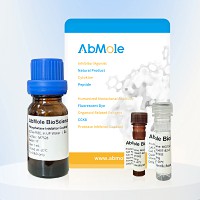All AbMole products are for research use only, cannot be used for human consumption.

Trypsin is a serine protease in the digestive system of human and animals. The main function of this enzyme is to hydrolyze proteins into smaller peptides or even amino acids. Trypsin cleaves peptides on the C-terminal side of lysine and arginine residues. The rate of hydrolysis of this reaction is slowed if an acidic residue is on either side of the cleavage site and hydrolysis is stopped if a proline residue is on the carboxyl side of the cleavage site. The optimal pH for trypsin activity is 7-9. Trypsin can also act to cleave ester and amide linkages of synthetic derivatives of amino acids. EDTA is added to trypsin solutions as a chelating agent that neutralizes calcium and magnesium ions that obscure the peptide bonds on which trypsin acts. Removing these ions increases the enzymatic activity.

Front Cell Neurosci. 2021 Oct 1;15:735723.
The Expression and Roles of the Super Elongation Complex in Mouse Cochlear Lgr5+ Progenitor Cells
Trypsin (porcine pancreas) purchased from AbMole
| Molecular Weight | 725.78 |
| Formula | C35H47N7O10 |
| CAS Number | 9002-07-7 |
| Solubility (25°C) | Soluble in water (10 mg/ml) Soluble in phosphate buffers (10 mg/ml) |
| Storage | 2-8°C, dry, sealed |
| Related Enzymes & Coenzymes Products |
|---|
| Glucose isomerase
Glucose isomerase can catalyze the reversible isomerization of D-glucose and D-xylose into D-fructose and D-xylulose, respectively. |
| β-Galactosidase (from Aspergillus oryzae)
β-Galactosidase acts on the terminal β-D-galactosyl moieties of disaccharides, glycoconjugates, and polysaccharides. It is useful in mediating transglycosylation reactions such as the synthesis of galactooligosaccharides (GOS). β-Galactosidases might be used for glycobiological and biotechnological applications. β-galactosidase cleaves lactose into its monosaccharide components, glucose and galactose. It also catalyses the transglycosylation of glucose into allolactose, the inducer of β-galactosidase, in a feedback loop. |
| Butyryl Cholinesterase (Horse serum)
Butyryl Cholinesterase is a serine hydrolase that is structurally similar to acetylcholinesterase (AChE) but has different substrate specificity and inhibitor sensitivity. The enzyme is a tetrameric glycoprotein composed of four identical subunits (110 kDa each) and is also known as pseudocholinesterase. It is synthesised in the liver and distributed in blood, neuromuscular junction synapses, glial cells and white matter axons. |
| β-Glucosidase (from Almonds)
β-Glucosidase is the main component of glycoside hydrolases that hydrolyse Glucoside into glucose and other constituents. β-Glucosidase works by breaking down fibre-rich cell walls to release and utilise the nutrients such as proteins and starch contained therein, while at the same time degrading the fibre to reducing sugars that can be digested and assimilated by the body of the animal. |
| Diaphorase
Diaphorase has been used in a study to assess the protein-protein interactions in assembly of lipoic acid on the 2-oxoacid dehydrogenases of aerobic metabolism. |
All AbMole products are for research use only, cannot be used for human consumption or veterinary use. We do not provide products or services to individuals. Please comply with the intended use and do not use AbMole products for any other purpose.


Products are for research use only. Not for human use. We do not sell to patients.
© Copyright 2010-2024 AbMole BioScience. All Rights Reserved.
